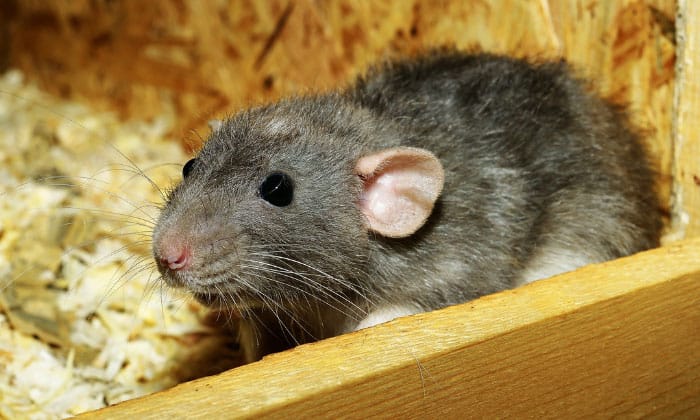Arizona has varied wildlife, with bears, chuckwallas, exciting birds, and more. There are also a fair number of rodents in Arizona!
What rodents can be found in this state? The 11 most common ones include rats, mice, voles, prairie dogs, chipmunks, gophers, muskrats, beavers, marmots, porcupines, and shrews.
Where do these rodents live, and what are some Arizona rodents’ identification? Find the answers to these questions and more below!
Table of Contents
Common Rodents in Arizona
From big to small, Arizona’s got them all. Here is a rundown of eleven frequently-spotted types of rodents in AZ.
1. Mice
Mice are found throughout the state in urban, suburban, and rural areas. They frequently build nests in walls, attics, and basements and feast on food scraps.
There are 70 species of mice across North America, but common Arizona mice include:
- House Mouse
- Pocket Mouse
- Cactus Mouse
- Canyon Mouse
- Eastern Deer Mouse
- White-footed Deer Mouse
- Brush Mouse
- Pinyon Mouse
- Fulvous Harvest Mouse
- Western Harvest Mouse
- Plains Harvest Mouse
- Northern Grasshopper Mouse
House Mouse Range Map

2. Rats
What’s the difference between rat vs mouse? Mainly, it’s size: rats are larger than mice.
While there are 64 rat species across the globe, most people attach the name to one particular species: the Brown rat.
Brown rats are known for living in the dank tunnels of sewers and subways but can be found nearly anywhere with people. They are opportunistic feeders that eat whatever they can find, even human waste.
However, many other rat species exist in Arizona and other parts of the world, such as kangaroo rats. Other rats live in forests or deserts and eat berries, seeds, fruit, and leaves.
All rats have long tails that give them incredible climbing and balance abilities. Interestingly, their tails also help them stay cool!
Aside from the brown rat, other rats that live in Arizona include pack rats, black rats, woodrats, and roof rats.
Brown Rat Range Map
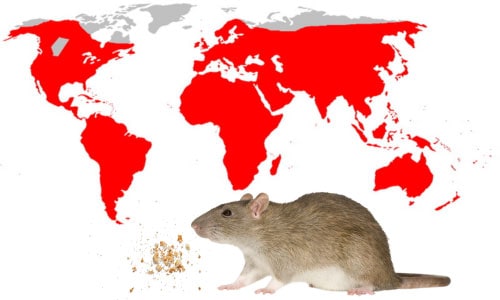
3. Voles
Voles are small animals, only 5-8 inches long, with stocky bodies, short legs, and short tails. This short tail is the easiest way to distinguish a vole from similar-looking mice.
Three of the twenty-three known vole species in the United States exist in Arizona.
However, these rodents are more commonly found in meadows, grasslands, and open forests rather than urban or suburban areas, making them harder to spot scurrying around.
Voles are active day and night year-round and eat various plants and animals. They are burrowers, frequently digging holes and intricate tunnel networks to look for food and build burrows for sleeping and protection.
Montane Vole Range Map

4. Prairie Dogs
Prairie dogs are a type of ground squirrel. Arizona is home to two of the five species in North America: Gunnison’s prairie dogs live in the north of the state, while Black-tailed prairie dogs are prevalent in the south.
They are called “dogs” because of their barking sound, while “prairie” refers to their natural habitats of open prairies, parks, and fields.
These mammals of Arizona often stand upright with their paws across their chest as if on the lookout.
Prairie dogs are smaller than groundhogs, measuring about 14 inches long. They do not have bushy tails like tree squirrels, sporting straight mid-length tails instead.
Gunnison’s Prairie Dog Range Map

Black-tailed Prairie Dog Range Map

5. Chipmunks
Chipmunks are the smaller cousins of the squirrel. While squirrels stand 15 inches tall on average, chipmunks are only 3-4 inches tall. Chipmunks also have stripes on their backs and thinner tails than squirrels.
These mischievous rodents can be found anywhere where food is available. People report spotting them in backyards, parks, open fields, and forests. They mainly eat seeds, nuts, and fruits but will also eat insects and bird eggs.
Arizona chipmunk species include the Cliff chipmunk, Gray-collared chipmunk, and the Hopi chipmunk.
Cliff Chipmunk Range Map
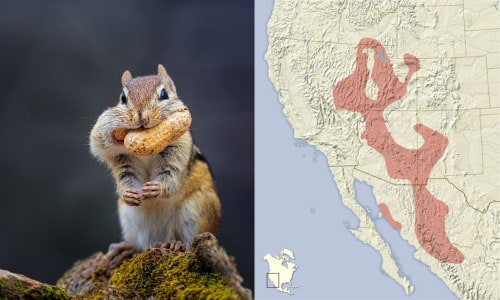
6. Pocket Gopher
Pocket gophers, or simply “gophers,” are 5-7 inches long and have thick bodies, slightly hairy tails, broad heads, small eyes and ears, and powerful clawed front feet made for digging.
Their exact color depends on their environment: Desert-dwelling gophers come in shades of yellows and light browns, while those living in areas with clay-rich soil have a more reddish-brown color.
The “pocket” in their names refers to their big cheeks used to transport food.
Gophers are herbivores found in almost any habitat with plants. Of the three species in Arizona, the most common Arizona gopher is the Botta’s or Valley pocket gopher.
Botta’s (Valley) Pocket Gopher Range Map

7. Common Muskrat
Muskrats are semi-aquatic rodents typically between 16-25 inches long, including the tail. They have short front legs, partially-webbed feet, and a flat, scaly tail. They also have dense fur that keeps them warm and helps them float.

Though the fur stays brown for most of their lives, it tends to fade to gray as they age.
These rodents live in marshes, streams, ponds, rivers, and lakes. They eat aquatic plants such as water lilies and cattails but may also consume animals such as snails, frogs, fish, and insects.
8. American Beaver

The American Beaver is the largest rodent in North America. Their bodies are 29-35 inches long, plus another 8-14 inches for their tail.
They have dark brown waterproof fur, webbed feet, and a flat, black tail. They are also known for their long teeth that appear orange due to numerous layers of enamel. These teeth grow continuously, requiring beavers to gnaw on wood to file them down.
Beavers build dams with trees, branches, and mud. These are used for shelter, food storage, and dens for raising young. They are found in almost all US states except Hawaii.
9. Yellow-bellied Marmot
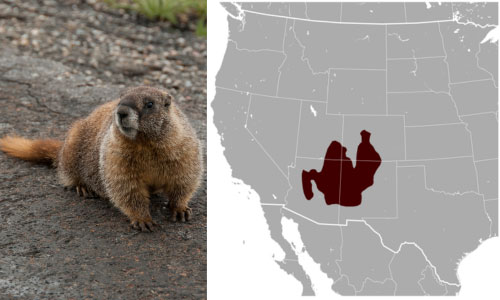
The yellow-bellied marmot is a type of ground squirrel and large burrowing rodent known as the rock chuck. It is found in southwestern Canada and the western United States mountainous regions.
They are stout rodents with brown fur, a dark bushy tail, a yellow chest and belly, and a white patch between the eyes. Typically, they are 18-27 inches long plus another 5-8 inches of tail.
They are commonly found in woodlands, forest openings, meadows, and grassy slopes. However, they can spend up to 80% of their life underground in burrows!
They are primarily herbivores but will also eat insects and bird eggs occasionally.
10. North American Porcupine

Porcupines are found in northern Arizona. They grow to a massive 32-46 inches long, including their tails. They have brownish-yellow to black fur and about 30,000 hollow white-tipped quills.
These rodents typically live in coniferous forests but may wander into wooded uplands and near streams. They are herbivores that thrive on vegetables, roots, bark, grass, and fruits.
11. Arizona Shrew
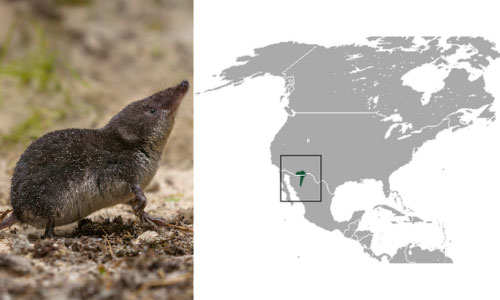
Arizona shrews are tiny, only 2-3 inches long, with a tail 1.5 inches long. They have grey to brown fur and long snouts.
These desert rodents only became a species in 1977 after being separated from Merriam’s shrews (which also exist in Arizona!).
They live in forested mountainous terrain with heavy undergrowth. They are found in southern Arizona, some Mexico, and New Mexico.
Rodents look cute and fluffy—but serious consequences can be felt once they start invading homes, particularly when they do so in large groups.
1. Impacts of Rodent Infestation
The biggest impact of rodent infestation is the spread of diseases either by getting bitten by one, consuming contaminated food, or receiving ticks, mites, and fleas from them.
Stress caused by long-term exposure can have impacts on mental health.
Some homeowners have reported developing musophobia or the fear of rodents. This gives them a constant paranoia that they are about to be bitten, get sick, or find gnawed food packaging in their pantry.
It can have devastating economic effects on businesses, too. Companies suffer when their products and infrastructure get contaminated or damaged by rodents.
2. Signs of Rodent Infestation in Arizona
Rats are a common problem for Arizona homeowners.
There are four quick signs your home may have rodents. These are:
- Droppings
- A strong smell of urine
- Gnaw marks on clothing, furniture, wiring, and food packages
- Scurrying, scratching, and thumping sounds in between walls and in the ceiling.
Rodent Control and Prevention
Here are some rodent solutions for prevention and elimination.
DIY Rodent Control Methods
- Keep your living spaces clean. Never leave food lying around, even pet food. Clean up spilled food immediately, and ensure your garbage bins have tight lids. If you are able, empty your garbage every day.
- Prevent rodent access. Seal gaps and holes inside and outside your home to prevent them from entering and traveling around inside.
- Note that mice can squeeze through even the tiniest of holes. These small rodents can fit in holes 1/4 inch wide—about the width of a pencil!
- Eliminate potential nesting areas. This includes regularly mowing your lawn and clearing out dead foliage and woodpiles.
- Encourage natural predators. Buy a pet cat or coax hawks and owls into your yard if you can. These animals are great rodent hunters and will cut down their population size quickly.
- Make homemade rat poison. Rat poison can be made by mixing one cup of peanut butter with half a cup of boric acid. Roll these into small balls and leave them in infested areas.
These balls will also be toxic to pets and children. Be very careful.
- Leave rat traps. There are three rat traps: mechanical traps that snap shut when rats approach bait, glue traps, and electric traps.
Professional Methods
If nothing works, it may be time to call a professional.
Though experts can be costly, they go beyond simply eliminating your rodents—they will also deal with the root cause that is attracting them in the first place.
Most pest control services offer complete packages of setting traps, leaving bait, and sealing all potential entry points. They typically cost between $300 and $550 but may be more depending on the severity of the infestation.
Frequently Asked Questions
Are there moles in Arizona?
Moles are not known to exist in Arizona. However, they look like voles, mice, and pocket gophers, confusing many homeowners.
Moles are found in eastern states and the southern Great Plains area.
What are the most common rodents in Arizona?
Native Arizona rodents are rats, house mice, and deer mice. These rodent species vary in size as well as nesting habits. However, they all can cause damage to homes as they rummage. Rodents are also the carriers of several diseases.
Conclusion
Rodents in Arizona are a varied group of desert, water, and forest dwellers. Some even invite themselves into residents’ homes.
Whether you want one as a pet, only appreciate them from afar, or don’t want to have anything to do with these rodents, they are here to stay.
After all, if they aren’t your thing, Arizona has many other things to offer, including its rich history and beautiful scenery.

George and I became friends after a birdwatching trip with our new group. And we have been enjoying every adventure together. When he told me the idea of establishing a site that shares our experiences and fun, I immediately agreed. After trials and errors, here we have Thayerbirding.



